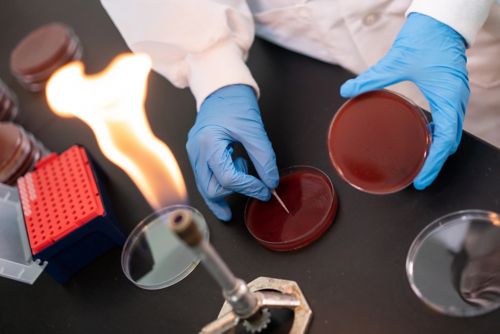St. Jude Family of Websites
Explore our cutting edge research, world-class patient care, career opportunities and more.
St. Jude Children's Research Hospital Home

- Fundraising
St. Jude Family of Websites
Explore our cutting edge research, world-class patient care, career opportunities and more.
St. Jude Children's Research Hospital Home

- Fundraising
On the road to resistance: How bacteria can win the game of life ‘with a little help from their friends’

Antibiotic resistance is a major human health crisis because infections that have been treatable for decades are no longer responding to the therapies in our arsenal. Findings from the laboratory of Jason Rosch, PhD, shed light on the steps bacteria need to take to travel the path of resistance.
To succeed in the computer game The Oregon Trail, which was popular with elementary school students in the 1990s, players had to obtain the right supplies and withstand obstacles and pitfalls to travel a great distance. Like in the game, microorganisms such as bacteria that want to survive and thrive must take steps to preserve their health, or “fitness,” and withstand an onslaught of factors that can cause their demise. For bacteria, antibiotics are one such factor. However, some bacteria have evolved to withstand antibiotics in a phenomenon called resistance.
Antibiotic resistance is a major human health crisis because infections that have been treatable for decades are no longer responding to the therapies in our arsenal.
“By the time bacteria become resistant, the problem's already here,” said Jason Rosch, PhD, St. Jude Department of Infectious Diseases.
Rosch is studying the factors that can influence the fitness of bacteria and their ability to travel the path that will help them avoid the effect of drugs, including the obstacles and strokes of good luck they will encounter on their way to achieving resistance.
“Understanding how they get to that finish line of becoming resistant is, I think, a really important question to figure out how they transition from a sensitive bug to a resistant one, and why only certain members of a species actually become resistant,” Rosch said.
A loss of fitness hinders the journey to resistance
Rosch and his team study Streptococcus pneumoniae (S. pneumoniae), a leading cause of pneumonia and meningitis in humans, which can also cause bloodstream infections and ear and sinus infections. While typically responsive to antibiotic treatment, S. pneumoniae is on the Centers for Disease Control and Prevention’s report of Antibiotic Resistance Threats in the United States as a ‘Serious’ threat (the middle of three categories, between ‘Urgent’ and ‘Concerning’).
Like the settlers heading West in The Oregon Trail, S. pneumoniae are faced with several different paths that they can take to secure their survival.
“What are the barriers for how bacteria become resistant?” Rosch asks. “There are only so many different paths these bacteria can take, so why do certain pathways get to this resistance phenotype while others don’t? We want to identify ways to interfere with those processes so we can eventually block the development of resistance.”
The simplest way to develop resistance, through the mutation of the bacteria’s own genes, is the most perilous because it can also cause the bacteria to lose their infectious ability. In Cell Reports Rosch and his team showed that when S. pneumoniae mutates on its own to try to become resistant, it loses the capacity to cause disease. This loss in fitness renders the pathogen unable to continue, and it dies out along its journey.
“Antibiotic resistance is really constrained by fitness,” Rosch said. “To ultimately succeed in a population, bacteria need the right combination of resistance and fitness. Resistance just isn't enough if you're not fit.”
Donor genes drive resistance through recombination
Unlike the players in Oregon Trail, bacteria can work together, getting a little help from their friends to help them navigate the road to resistance. If S. pneumoniae swap their DNA, in a process called recombination, the bacteria can gain the mutations needed to develop antibiotic resistance at a much lower cost to its health than if a single bacterium was trying to mutate itself. Thus, S. pneumoniae can make quick progress down the path toward resistance without losing their fitness.
“Recombination allows these bacteria to leapfrog the issue of fitness,” Rosch said. “Rather than plodding along a path taking small steps, small mutations, recombination allows the bacteria to take a giant leap forward all at once which seems to be what is needed to achieve resistance while staying fit.”
“Think of it almost like a valley that you have to cross,” Rosch adds. “If the bacteria must traverse this huge valley taking little steps, eventually they will run out of resources and won’t make it across. Whereas if the bacteria can take a bridge straight over, they’ll make it to the other side intact.”
Interestingly, Rosch and his team also found that a recombination event between two bacteria that are sensitive to antibiotics can still result in resistance if the right genes are swapped.
Charting the rules of resistance
Whether you are playing a computer game with the goal of getting your settlers to Oregon, or a bacterium playing the game of life trying to do whatever it takes to thrive, there are insights to be gained from studying the processes that lead to success. Knowing the rules of the game can help you make sense of why things happen the way that they do – and help you avoid the pitfalls that can set your journey astray.
“For a lot of bacteria, we just don’t know what the rules are for developing antibiotic resistance,” Rosch said. “We know that it occurs, but what are the rules and constraints involved in the process? What pathways do these bacteria take and are there certain routes that they can’t go down because the fitness costs are too high? This study helped us answer these questions for S. pneumoniae and provide a blueprint that might be applicable to other bacteria as well.”
The first authors of the study are Andrew Nishimoto, PhD, and Tina Dao, both of the Department of Infectious Diseases.






